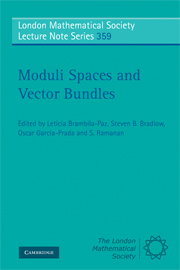Preface
Published online by Cambridge University Press: 07 September 2011
Summary
Vector bundles and their associated moduli spaces are of fundamental importance in algebraic geometry. In recent decades the richness of the subject has been enhanced by its relationship to other areas of mathematics, including differential geometry (which has always played a fundamental role), topology (where the moduli spaces not only present interesting topological features but turn out to be useful in settling topological problems) and, perhaps most surprising of all, theoretical physics, in particular gauge theory, quantum field theory and string theory.
The concept of stability for vector bundles, and the ensuing construction of the moduli spaces which classify these bundles, goes back more than 40 years to the fundamental work of Mumford and of Narasimhan and Seshadri. Since then, there has been much progress in describing the detailed structure of these spaces using methods from pure algebraic geometry, topology, differential geometry, number theory, representation theory and theoretical physics.
Peter E. Newstead has been a leading figure in this field almost from its inception and has made many seminal contributions to our understanding of moduli spaces of stable bundles. His “Tata lecture notes” have helped an entire generation of algebraic geometers learn the foundations of moduli theory and vector bundles. He is Chair of the international research group “Vector Bundles on Algebraic Curves” (VBAC), which he initiated in 1993 and whose purpose was to encourage the development of this area of research, particularly among young mathematicians.
- Type
- Chapter
- Information
- Moduli Spaces and Vector Bundles , pp. vii - viiiPublisher: Cambridge University PressPrint publication year: 2009



